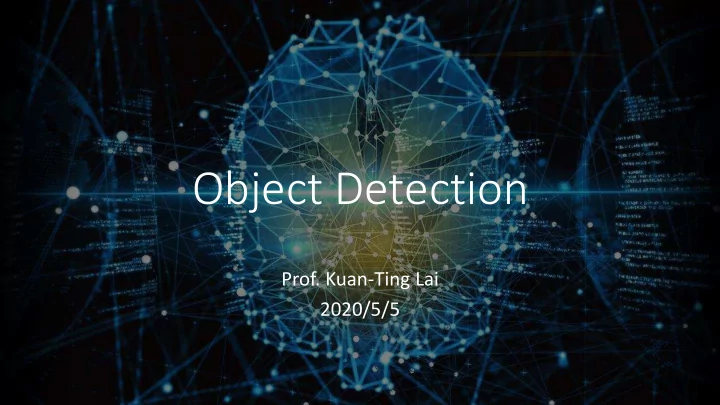

Object Detection Prof. Kuan-Ting Lai 2020/5/5
2
YOLO v2 https://www.youtube.com/watch?v=VOC3huqHrss&t=40s 3
Detection vs Classification • Classification − Ex: ImageNet Large-scale Visual Recognition Challenge (Classify 1000 categories) • Detection = Binary Classification 4
Recent Developments of Object Detection • Deformable Part Model (2010) • Fast R-CNN (2015) • Faster R-CNN (2015) • You Only Look Once: Unified, real-time object detection (2016) • SSD: Single-Shot Multi-box Detector (2016) • Mask R-CNN (2017) (Segmentation) • YOLO9000: Better, Faster, Stronger (2017) • YOLOv3: An Incremental Improvement (2018) 5
6
Objectness and Selective Search 7
Region Proposal: Multi-scale Objectness Search • Scan all possible locations and scales for objects
Region Proposal + CNN = R-CNN 9
10
Problems with R-CNN • 2000 region proposals per image • It takes around 47 seconds for testing one image • The selective search algorithm is a fixed algorithm using shallow architecture 11
Fast R-CNN • Instead of running a CNN 2,000 times per image, run just once per image and get all the regions of interest (RoI) 12
Faster R-CNN • Replace Selective Search with neural networks 13
Faster R-CNN Architecture 14
R-CNN Test-Time Speed 15
Summary Algorithm Features Prediction time Limitations • Uses selective search to High computation time generate regions. RCNN 40-50 secs as each region is passed • Extracts around 2000 regions to the CNN separately from each image. • Each image is passed only once to the CNN and feature maps are Selective search is slow Fast RCNN extracted. 2 secs and hence computation • Selective search is used on these time is still high. maps to generate predictions. • Replaces the selective search Object proposal takes Faster RCNN method with region proposal 0.2 secs time network. 16
YOLO – You Only Look Once 17
YOLO v1 • Divide an image into S x S grid • Predict bounding box B as (x, y, w, h, confidence) • Each grid predicts B bounding boxes and C class probabilities • Final prediction: S x S x (B*5 + C) 18
Limitation of YOLO 19
YOLO v2 – YOLO 9000 • Batch normalization • High-resolution classifier • Convolutional with Anchor Boxes https://heartbeat.fritz.ai/gentle-guide-on-how-yolo-object-localization-works-with-keras-part-2-65fe59ac12d 20
Anchor Boxes • Detecting objects with different shapes • Detecting overlapping windows https://www.coursera.org/lecture/convolutional-neural-networks/anchor-boxes-yNwO0 21
Using K-means Clustering to Find Anchor Boxes 22
DarkNet • For ImageNet − VGG (30.69 billion FLOPS) − GoogLeNet (8.52 billion FLOPS) − DarkNet (5.58 billion FLOPS) • DarkNet uses mostly 3 × 3 filters to extract features and 1 × 1 filters to reduce output channels 23
Hierarchical Classification 24
Performance of YOLOv2 on VOC 2007 25
YOLO v3 26
YOLO v4 • A. Bochkovskiy, C.-Y. Wang, H.-Y. Mark Liao , “YOLOv4: Optimal Speed and Accuracy of Object Detection”, 2020 • https://github.com/AlexeyAB/darknet 27
New Techniques Adopted in YOLO v4 • Weighted-Residual-Connections (WRC), • Cross-Stage-Partial-connections (CSP) • Cross mini-Batch • Normalization (CmBN) • Self-adversarial-training (SAT) • Mish-activation • New features: − WRC, CSP, CmBN, SAT, Mish activation, Mosaic data augmentation, CmBN, DropBlock regularization, and CIoU loss 28
Single-Shot Multi-Box Object Detection (SSD) 29
Dimensions of SSD Feature Maps 30
Feature Pyramid Networks (FPN) 31
Bottom-up and Top-down 32
SSD (Bottom-Up) • Using only upper layers as feature maps 33
FPN (Top-Down) 34
FPN Architecture 35
Focal Loss • Solve class imbalance problem by reducing loss for well-trained class 36
RetinaNet 37
EfficientDet • Based on EfficientNet − Mingxing Tan Ruoming Pang Quoc V. Le, ‘‘ EfficientDet: Scalable and Efficient Object Detection”, Google Research, Brain Team 38
PyTorch Version of EfficientDet • 25.86x faster that original TensorFlow version! • github.com/zylo117 39
40
41
Segmentation https://www.analyticsvidhya.com/blog/2019/07/computer-vision-implementing-mask-r-cnn-image-segmentation/ 42
4 3 Running Mask R-CNN https://github.com/matterport/ Mask_RCNN.git
Install Prerequisites *Create a virtual environment with TensorFlow=1.3 and Keras=2.1 1. git clone https://github.com/matterport/Mask_RCNN.git 2. pip3 install -r requirements.txt 3. python3 setup.py install 44
Download Pre-trained Weights (MS COCO) • https://github.com/matterport/Mask_RCNN/releases/download/v2.0/mas k_rcnn_coco.h5 45
Training Custom Object Detector on Colab • https://medium.com/analytics-vidhya/custom-object-detection-with- tensorflow-using-google-colab-7cbc484f83d7 46
Reference • https://pjreddie.com/ • https://towardsdatascience.com/r-cnn-fast-r-cnn-faster-r-cnn-yolo-object- detection-algorithms-36d53571365e • https://www.analyticsvidhya.com/blog/2018/10/a-step-by-step- introduction-to-the-basic-object-detection-algorithms-part-1/ • https://heartbeat.fritz.ai/gentle-guide-on-how-yolo-object-localization- works-with-keras-part-2-65fe59ac12d • https://towardsdatascience.com/retinanet-how-focal-loss-fixes-single- shot-detection-cb320e3bb0de • https://medium.com/@jonathan_hui/what-do-we-learn-from-single-shot- object-detectors-ssd-yolo-fpn-focal-loss-3888677c5f4d 47
Recommend
More recommend